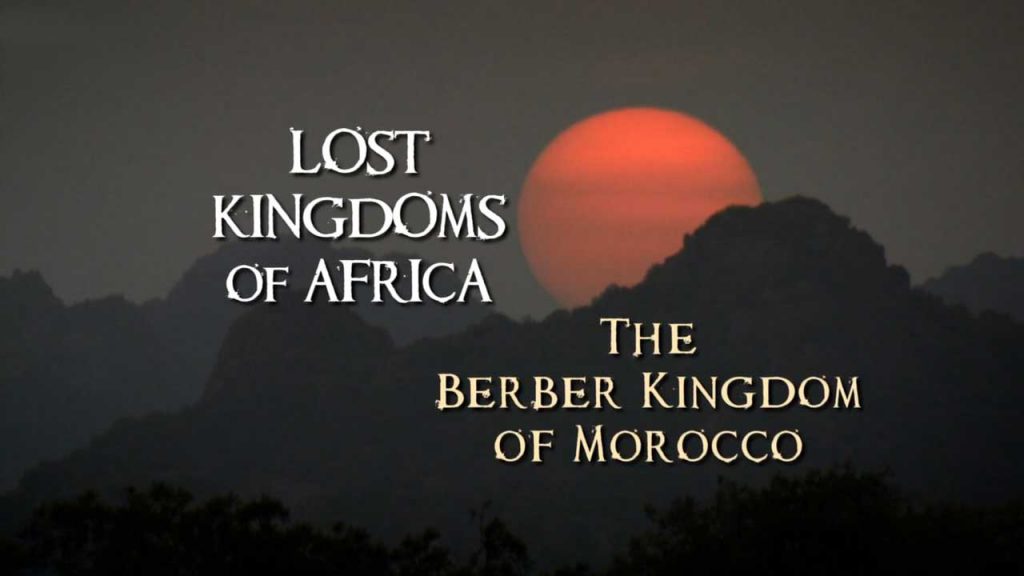Lost Kingdoms of Africa episode 7 – Berber Kingdom of Morocco: Gus Casely-Hayford visits Morocco, once the centre of a vast kingdom created by African Berbers that stretched from northern Spain to West Africa. We know less about Africa’s distant past than almost anywhere else on Earth. But the scarcity of written records doesn’t mean Africa lacks history. It is found instead in the culture, artefacts, and traditions of the people. Art historian Dr Gus Casely-Hayford explores some of the richest and most vibrant histories in the world, revealing fascinating stories of complex and sophisticated civilisations: The Kingdom of Asante; The Zulu Kingdom; The Berber Kingdom of Morocco; The Kingdoms of Bunyoro & Buganda.
It’s easy to think of Islamic North Africa as Arab, rather than African. But the land that is now Morocco once lay at the centre of a vast African Kingdom that stretched from northern Spain to the heart of West Africa. It was created by African Berbers, and ruled for centuries by two dynasties that created tremendous wealth, commissioned fabulous architecture, and promoted sophisticated ideas. But art historian Dr. Gus Casely-Hayford reveals how the very forces that forged the kingdom ultimately helped to destroy its indigenous African identity.
Lost Kingdoms of Africa episode 7 – Berber Kingdom of Morocco
The term Berber comes from the Greek: βάρβαρος (barbaros pl. βάρβαροι barbaroi) which in Ancient Greece meant “non-Greek-speaking” or “non-Greek peoples”. The Romans also used the word to refer to their neighbours to the north, in Germania (roughly the area that is modern-day Germany), as well as to Celts, Iberians, Gauls, Goths, and Thracians. Among the oldest written attestations of the word Berber is its use as an ethnonym in a document from the 1st century AD Periplus of the Erythraean Sea. Gabriel Camps argues that the name of the Berbers does not derive from “barbarian”, as usually thought, but from the name of the tribe of the Bavares.
In ancient and medieval times, the Greeks, Romans, and Byzantines all used words which are similar to “Berber” in reference to various tribes that inhabited “Greater Libya” (that is, the area which is now called North Africa), in areas where Berbers were later to be found. Although the following tribal names differ from the names used in those classical sources, they are nevertheless probably related to the modern Amazigh. The Meshwesh tribe was the first of these tribes to be identified by researchers. Scholars believe it is the same tribe that was called Mazyes by the ancient Greek writer Hektaios and Maxyes by the ancient Greek historian Herodotus. In Latin sources, the tribe was called Mazaces and Mazax, and was related to the later Massylii and Masaesyli. Late antiquity Roman and Coptic language sources record that a tribe referred to as Mazices conducted multiple raids against Egypt. All these names are similar to the names used by the Berbers to refer to themselves, and are perhaps foreign renditions of that name: Imazighen or i-Mazigh-en (singular: a-Mazigh).
Despite the evidence in these early manuscripts, certain modern scholars have argued that the term only emerged around 900 AD, in the writings of Arab genealogists. For example, Maurice Lenoir posited that the term first appeared in the 8th or 9th century. Ramzi Rouighi argues that the use of Berber to refer to the people of North Africa appeared only after the Muslim conquests of the 7th century. Latin and Greek sources describe Moors, Africans, and even barbarians, but never Berbers (al-Barbar). The English term was introduced in the 19th century, replacing the earlier Barbary.




